What to look for when buying a used trailed sprayer
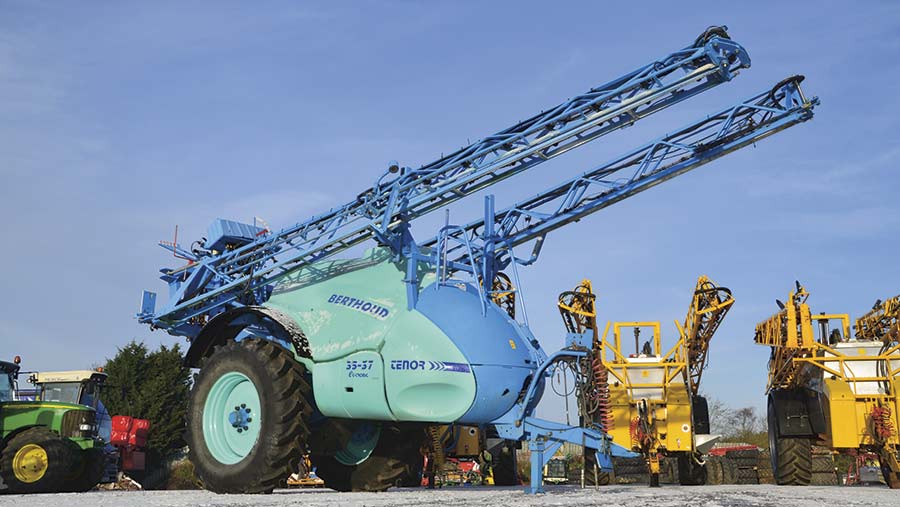 © Nick Fone
© Nick Fone There are plenty of good reasons to run a trailed sprayer. Not only will modern machines match the capacity of their self-propelled equivalents but they’ll also equal them in terms of the technological sophistication they can offer.
Auto-section shut-off, boom height control, steering and suspension are now commonplace on most machines built in the past five years.
And then there’s the financial side of things. Not only do tractor-towed sprayers cost less to buy in the first place, without an engine, complex hydrostat pumpset and expensive to replace wheel-motors, they also have the potential to offer significantly lower running costs.
And if you choose to hitch them up to a tug equipped with a stepless continously variable transmission gearbox, you can drive them on the stick just like any hydrostat, if that’s what floats your boat.
While a large self-propelled machine is going to set you back close to £200,000, any decent specification trailed sprayer is still going to come in close to the £100,000 mark.
Significant outlay
Although that’s relatively easy to justify for big farming businesses and contracting outfits, given the value of the products they’re applying and the acreages they’re covering, for smaller operations, it’s still a massive lump to swallow.
But help is at hand. With more and more self-propelleds being replaced by traileds, top-spec tractor-towed rigs are now starting to trickle through to the second-hand market.
Big estates and agri-businesses will run a sprayer for a given payback period, budgeting for its replacement at the end of that time.
For that reason there are plenty of top-spec trailed sprayers sitting in dealers’ yards that are by no means worn out and have the potential to do at least another 20 years’ hard graft on a smaller farm.
And there’s some serious value to be had out there. A 10-year-old machine might be badged up with a ticket price of just 20% of its original value.
Where better place to get some advice on what to look out for than one of those dealers – Lincolnshire-based Avison Sprayers?
See also: Suffolk farmer rates his JCB Fastrac 4000 and Landquip demount sprayer
What to look for
1. Pumps

© Nick Fone
Generally, you’re looking at one of two options – ultra-common diaphragm-piston pumps, or higher-output centrifugal units (often found on machines destined for lots of high-volume fertiliser work – an area Chafer specialises in).
Most tend to hail from Italy and are pretty simple things to repair or rebuild. On that basis, don’t get too put off if the pump looks like it’s not in very good nick – it’ll only be a maximum of £500 to reinvigorate, compared with £1,000-£1,500 for a new one.
Most have plastic-coated aluminium bodies, so if the outer layer is beginning to peel away it might be a sign that it’s been left out in the frost on a regular basis, or things have got a bit hot at some point.
Generally, that’s down to oil levels getting low. Check there’s the right amount of clean lubricant in the reservoir but on newer Altek units, it won’t show up on the sight glass – you need to get it up and running before it gets up to its level.
With centrifugal pumps, there are generally very few issues, unless they’ve been run dry from time to time. If that’s the case they’ll tend to leak, their seals having cooked.
2. Booms
Open up the booms and look for cracks and fatigue in the obvious stress points, the most obvious being the inner hinge on the back-frame. Nothing’s a major drama on a steel boom – everything’s easily welded.
If the outer boom sections are drooping, often that’s a sign of wear in the hinge pins. Again that’s generally easily resolved with new nylon or stainless bushes and pins –typically £50-£100 for a pair.
3. Back-frame
When it comes to back-frames there are generally two designs to look at – vertical height masts/ladder frames or parallelogram linkages.
The former tend to employ a series of steel or nylon rollers running inside a channel trackway. Typically they run on grease-able pins rather than actual bearings.
If they seize or fail, they’ll quickly wear a flat-spot but again, they’re no biggy to replace and will generally cost around £50 each to change.
By the nature of a parallelogram linkage, you’ll have a minimum for eight pins and bushes to check. The easiest way to do that is to unfold the booms, grab hold of them and lift one side – if you can see the parallelogram twisting then it’s going to require a bit of work.
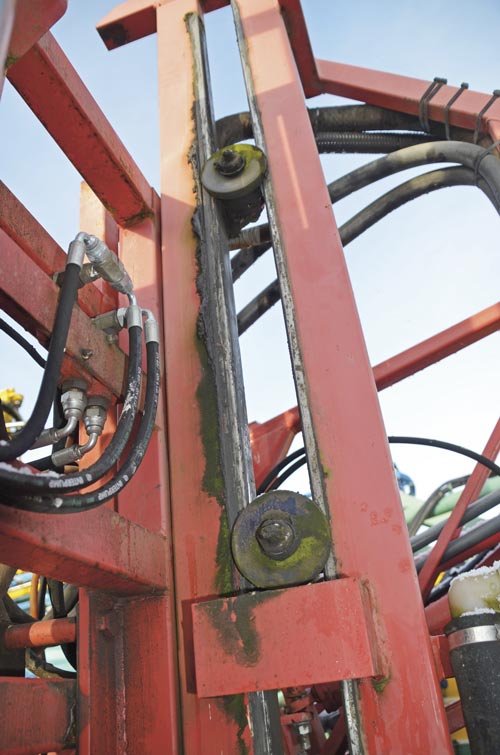
© Nick Fone
4. Tracking drawbar and headstock
While it doesn’t get more simple than a ring-hitch, a good number of trailed sprayers run on the lower link arms with horizontal and vertical pivot points allowing the headstock to twist in all planes. Generally, they’re just standard bushes and pins off the shelf and are fairly straightforward to change.
While you’re around the front end it’s a good time to take a look at hoses, pipe and wiring for chafing or pulling.
5. Steering axles
There are a number of different steering systems fitted to the most common brands of trailed sprayers.
A good number employ the Tec set-up with potentiometers on the drawbar and axle sending a position feed to a control box that then directs oil via a valve chest to rams on the axle that align the wheels to follow the required track.
Others fitted with a Muller controller have a system that uses a mini gyroscope that hooks to the back of the tractor and, using a series of sensors, detects the turn angle again sending oil in the appropriate direction.
Either way, check the system works. If not, it’s generally down to a small electrical glitch – often within the wiring. If it’s a fault inside the control box, it can prove hard and expensive to get hold of a replacement.
However, Chafer now makes its own replacement for the Tec controller (about £900) or there’s always the option of contacting technology wizards David King Electronics for a repair.
6. Electronics
There’s generally one key difference that sets UK-built sprayers apart from their European counterparts.
While those built on our shores tend to employ simple electronic control boxes with straightforward wiring circuits handling individual functions, foreign brands have moved towards ultra-sophisticated set-ups using microprocessors and CAN bus networks to handle the entire machine’s workings.
Although this offers huge potential for the automation of various functions and the diagnosis of faults, when things go wrong with the system itself, it’s generally very hard to find anyone who can repair it, which means you’re going to need a costly replacement box to sort the problem.
This is one of the key factors determining a sprayer’s second-hand value. You’ll often see European-built machines advertised for significantly less than their UK counterparts purely for this reason.
7. Section control valves
With just the electrics on the sprayer up and running, get a second set of ears around to the back and, as you flick individual sections on and off, get them to listen out for the motorised valves working – they should run for about half a second to go from fully open to fully closed.
If it’s possible to get a tank full of water, run the pump up and get some liquid coming through the nozzles. Then shut them all off but keep the pump running to keep pressure up in the lines.
If bodies in specific sections continue to drip, it’s likely the valve needs attention. Repair kits are available from outfits like Sprayer Spares at Metheringham near Lincoln but often it’s simpler just to replace the whole valve at a cost of around £300-£500 each.
Look at the complete valve bank – if individual units have already been replaced, it makes sense that others are likely to need changing in the near future – they’ll all have done a similar amount of work after all. Factor that into what you’re prepared to pay for the machine.
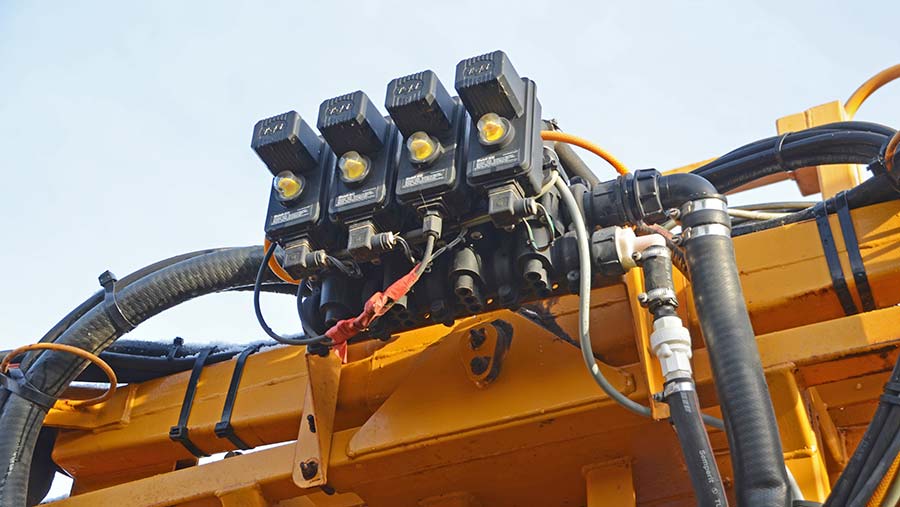
© Nick Fone
8. Tanks
You’ve typically got three options for the materials that main and clean water tanks are made from – fibreglass, polypropylene or stainless steel.
All have their pros and cons. Generally, stainless ones are the most bombproof option – they can take knocks and dings without affecting their integrity. If a leak does develop it’s a relatively simple task for a welder to get it sorted with electric glue.
Some tanks are prone to fatigue in certain spots. For example, some of Chafer’s Guardian sprayers suffer at the point where three seams come together – the company now provides a circular patch to weld in to strengthen it all up.
Polypropylene tanks are an altogether different story. Years of sunshine, weathering and frosts can mean they become brittle and they’re generally a real problem if they develop a crack. Plastic welding is an option but it’s not always successful.
However, the alternative isn’t very palatable either – they’re thousands to change and so that can often see a perfectly good machine written off.
Traditionally favourite with the usual suspects in the UK sprayer game, fibreglass tanks might not look the sexiest but are pretty straightforward to sort if problems develop.
Typically, leaks occur around the split seam, although years of chemical and liquid fertiliser can take their toll on the main mouldings, attacking the resin. Stick your head in the top hatch and look out for obvious spots where fibres are hanging down.
You should be able to track down a local fibreglass specialist who will come and grind out the joints and reseal the problem spots. Allow a day of time for them to sort any leaks.
If the clean water tank is a separate external vessel, it’s pretty easy to spot any leaks. However if it’s an integral internal set-up, it’s not quite so easy to diagnose. Fill it right up and wait to see if the levels drop.
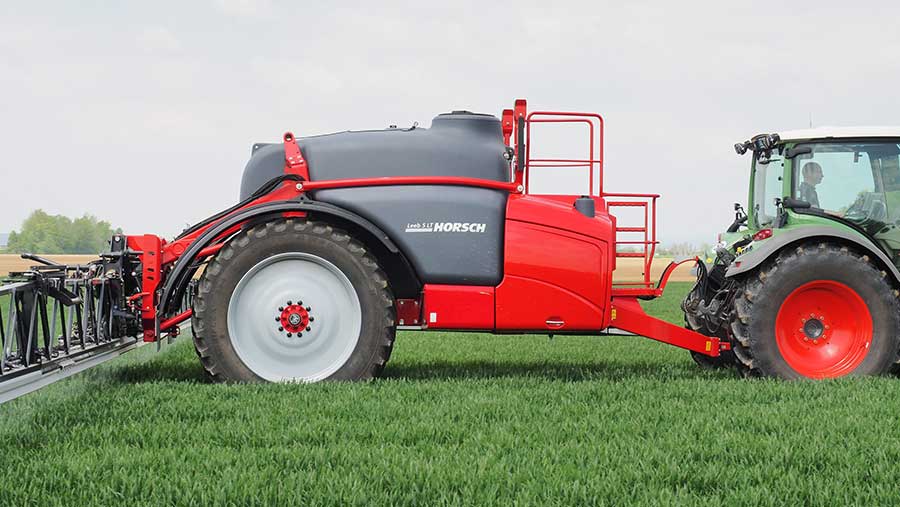
© Jonathan Page
9. Air suspension and air shut-off
Many trailed sprayers employ pneumatic systems to activate their section shut-offs. Some require an air supply from the tractor, others have their own on-board compressor running off a 12V feed from the tractor.
They’re not brilliant at passing the test of time but it’s not the end of the world to replace them – budget £500-£1,000 for a new unit.
The control boxes that do the clever stuff rarely give trouble, but if the system isn’t working properly, it’s usually a David King job once again.
Depending on the level of spec and the boom suspension system fitted, some machines will also have axle suspension, a good number using truck-type air-bags.
Over time, these can perish and leak, but they’re a simple off-the-shelf item with any commercial vehicle outfit.
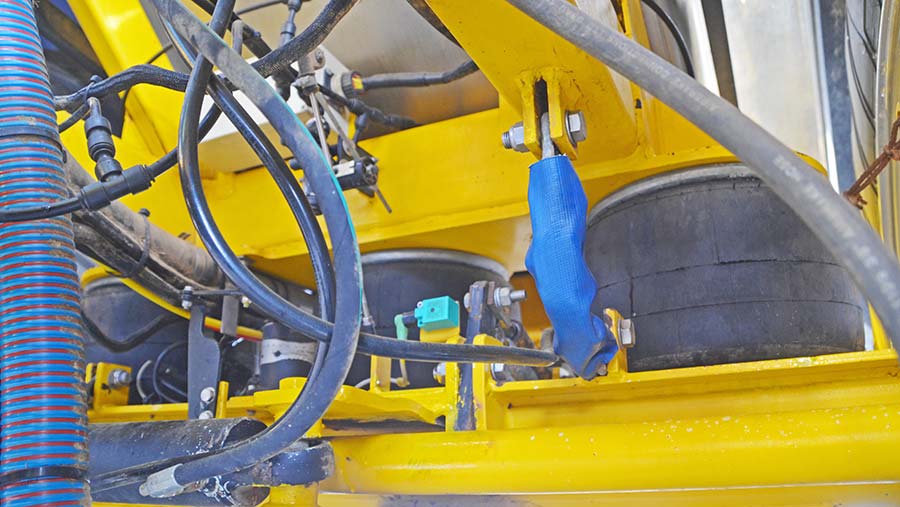
© Nick Fone
Essential spec
- Boom recirculation – now considered to be the norm on modern, up-together sprayers, a machine without twin-line recirculation is likely to be worth around £1,500 less than one with it. Retrofitting will cost at least £2,000.
- GPS section control – if fitted with satellite-guided auto section shut-off, expect to pay around £2,000-£4,000 more for a 24m machine. Retrofit kits don’t come in at much less than £5,000 installed.
- Auto height control – boom height control systems are becoming more widespread but won’t necessarily add anything to a second-hand machine’s value as they’re not always that reliable and take quite a bit of work to keep performing as they should. With the tractor running, wave a hand under the sensors and check that the hydraulics respond as they should. Retrofitting costs in the region of £6,000 upwards.
- Steering axles – now expected on any trailed sprayer, a machine without axle steering could be worth £5,000 less than one with it.
- Wheels and tyres – generally expect to get one set of multi-purpose rubber with a used machine. A good set of rowcrops will set you back £1,000 and flotations at least £1,500.
- Aluminium (Pommier) booms – lightweight booms don’t add a great deal to the value of a used sprayer, despite costing a lot more in the first place.
What’s on the market?
Just as a guide, here are a few examples of what you can get. Prices will vary so we’ve given a range for each, the lowest figure for a sprayer that’s really suffered the test of time, the top end for a machine in concourse condition.
5,000 litre Chafer Sentry (2010)
- 36m booms
- TeeJet Matrix GPS section control and mapping
- Steering axle and Norac auto boom height control
- £23,000-£28,000
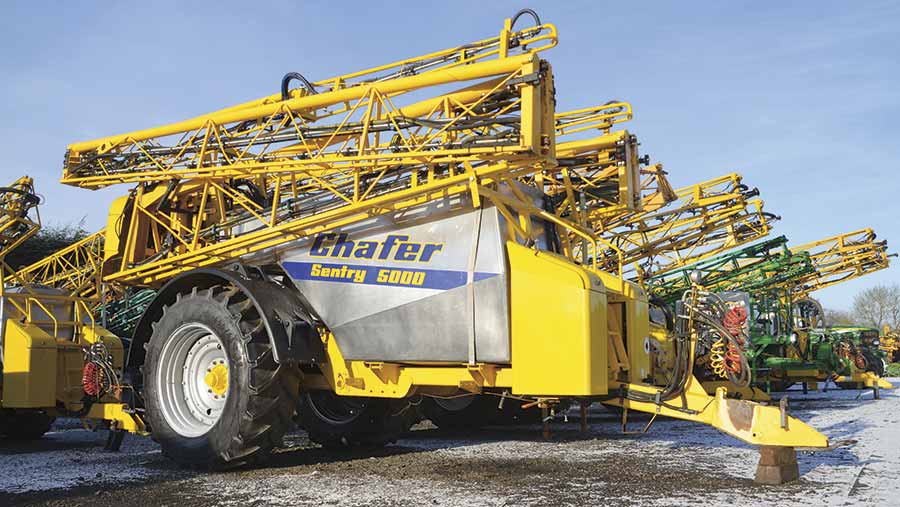
© Nick Fone
“This has the potential to be a high-output machine and with a centrifugal pump can do high volumes, making it ideal for liquid fert. However that’s a potential downside – if it’s done lots of fert work, corrosion is likely to have taken its toll.” – Gary Avison
3,500 litre Berthoud Tenor (2013)
- 30m booms
- Berthoud rate controller
- Auto steering, auto height control
- £20,000-£25,000

© Nick Fone
“Seriously good value for money when you consider its age and the work it has done. You’d pay a lot more for a UK-built machine but if something goes wrong it’s a lot more costly to fix.” – Gary Avison
3,600 litre Knight EU (2007)
- 24m booms
- LH Agro rate controller
- £12,000-£18,000
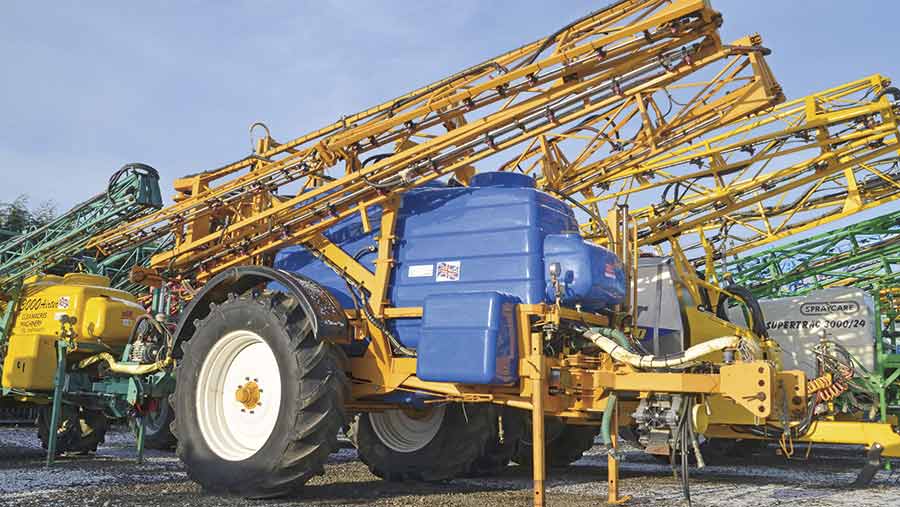
© Nick Fone
“Don’t get concerned about the colour of the tank. Knight did a special spec for Anglia Sprayers with a Udor pump, manual fill valves, an LH Agro controller and a blue tank. In reality there’s no difference in performance – the EU is a strong, solid performer.” – Gary Avison
3,000 litre Househam Spraycare (2008)
- 12/24m booms
- TeeJet Autoflow rate controller
- Rowcrops
- £10,000-£15,000
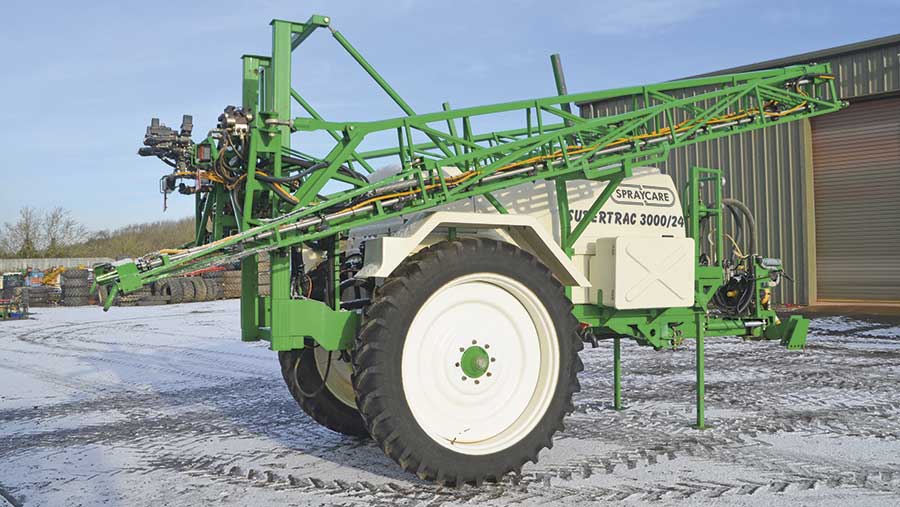
© Nick Fone
“A really nice, simple spec machine – ultra reliable and decent value. Very litlle automation but will do pretty much everything that’s asked of it.” – Gary Avison
3,000 litre Cleanacres Airtec (2004)
- 24m booms
- Forced air inclusion
- RDS auto flow controller and tracking drawbar
- £10,000-£14,000
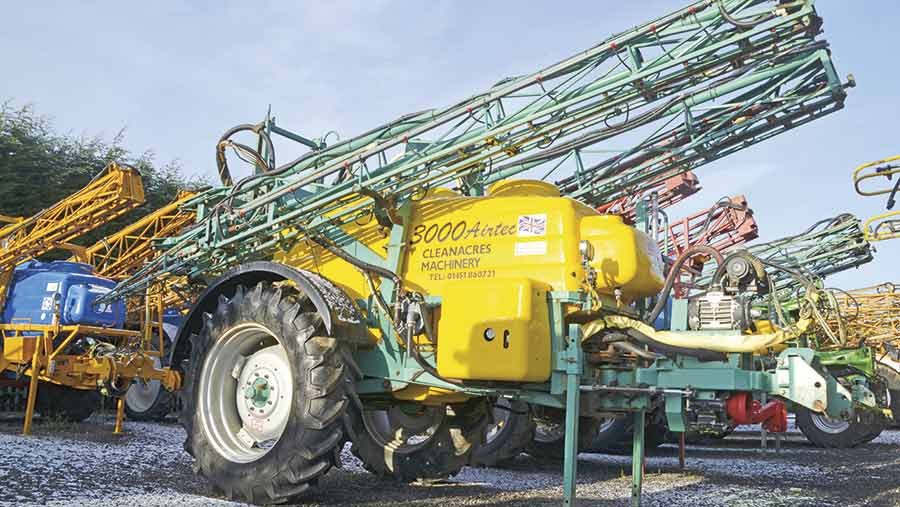
© Nick Fone
“Built by Knight after about 2000, Cleanacres sprayers are good, strong machines and had the advantage of the Airtec system that meant you could run at reduced rates with less risk of drift. That said, modern nozzle technology seems to have superseded the system.” – Gary Avison
3,200 litre John Deere 832i (2008)
- 24m booms
- JD 2600 control with GPS auto section control
- Auto height control and steering drawbar
- £10,000-£14,000
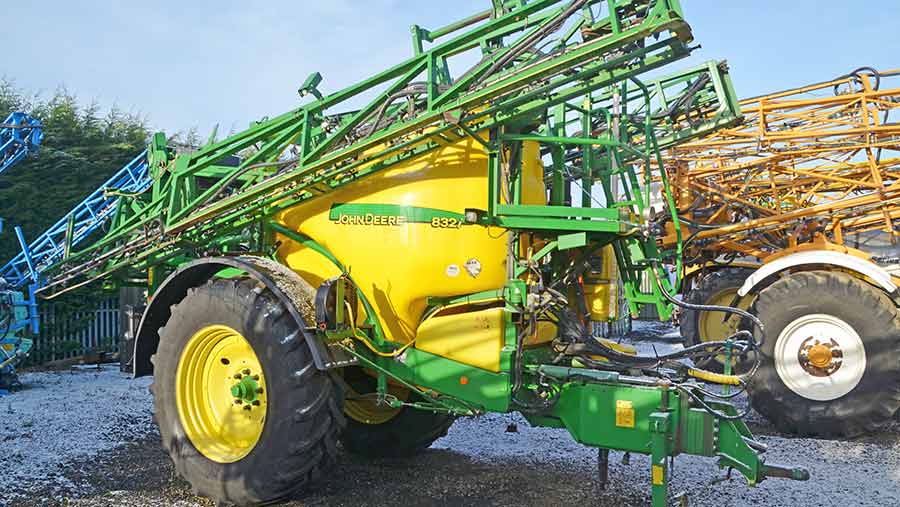
© Nick Fone
“Represents very good value for money spec-wise but can be troublesome and very complicated to fix – the price reflects that. A non ‘i-spec’ machine would fetch more money second-hand due to its simplicity.” – Gary Avison
2,800 litre Hardi Commander (2004)
- 21m booms
- Hardi rate controller
- Boom suspension (rather than axle damping)
- £6,000-£8,000
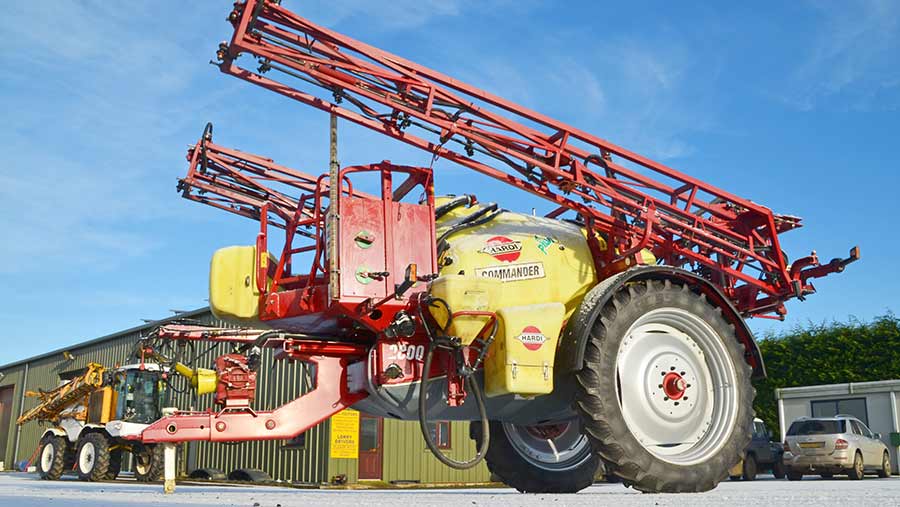
© Nick Fone
“A really simple spec sprayer with no steering. A cheap machine that will do a job so long as you haven’t got too many acres to cover. Build quality at that time wasn’t quite up to the standard of UK-built machines.” – Gary Avison

